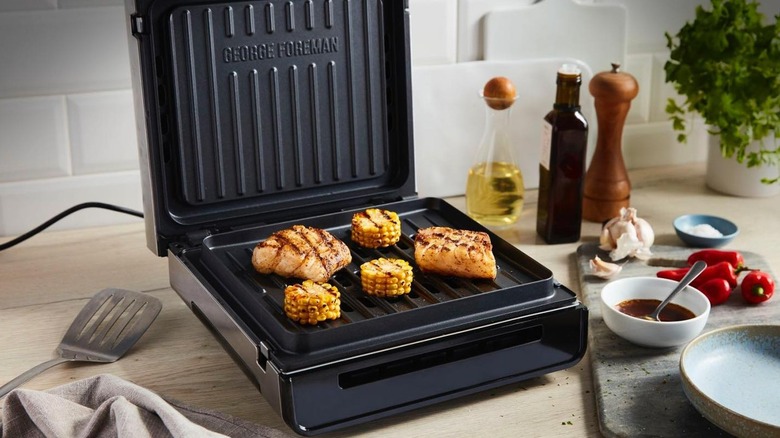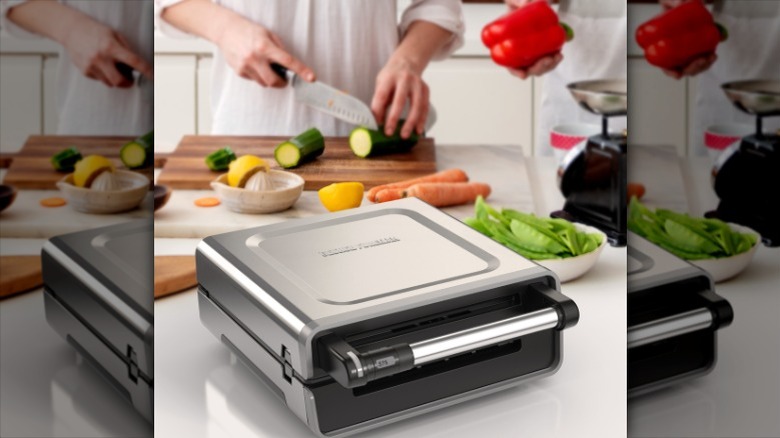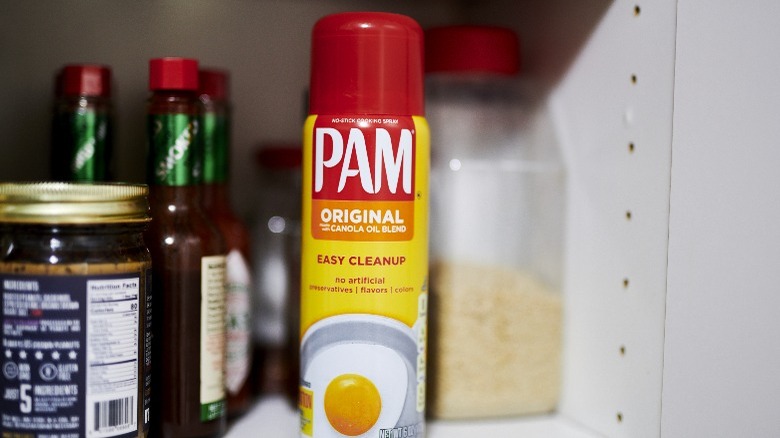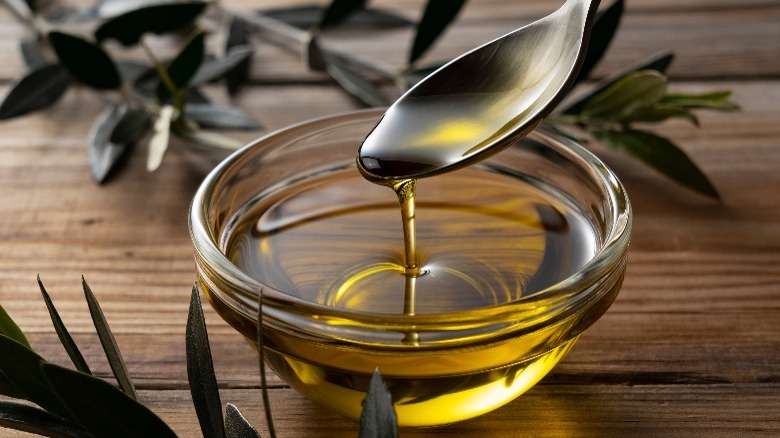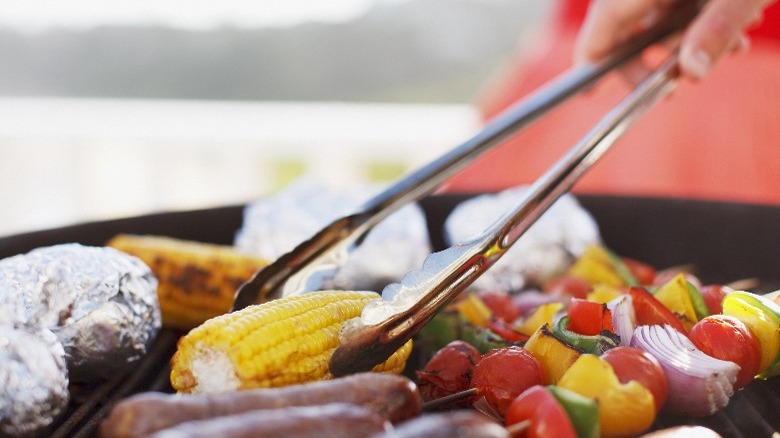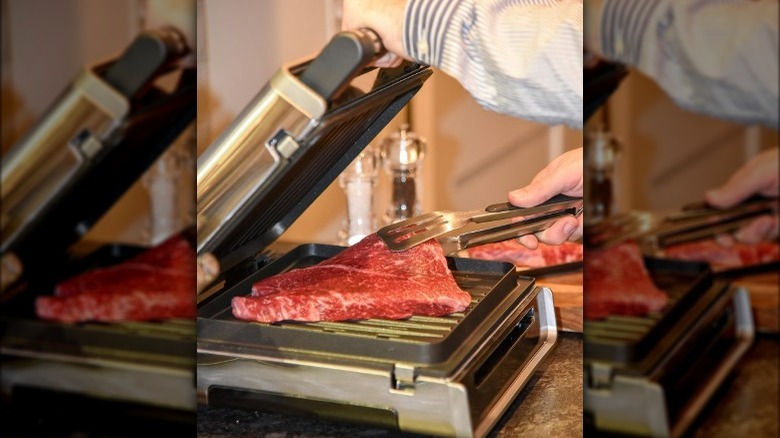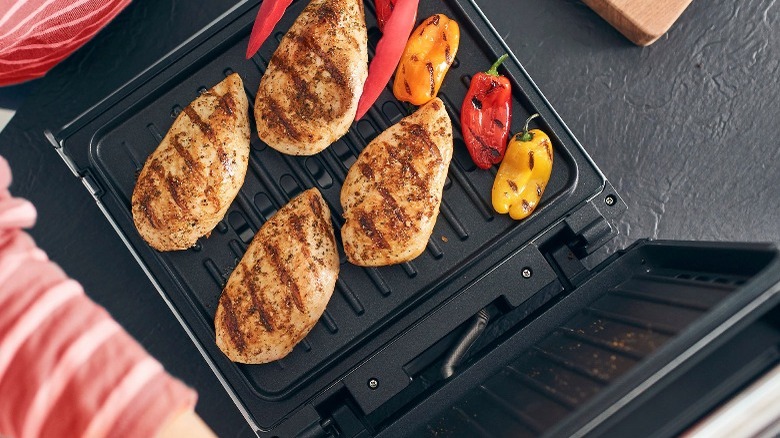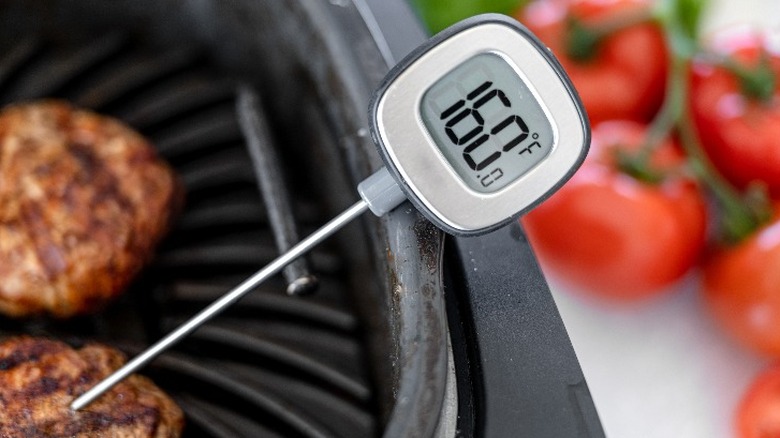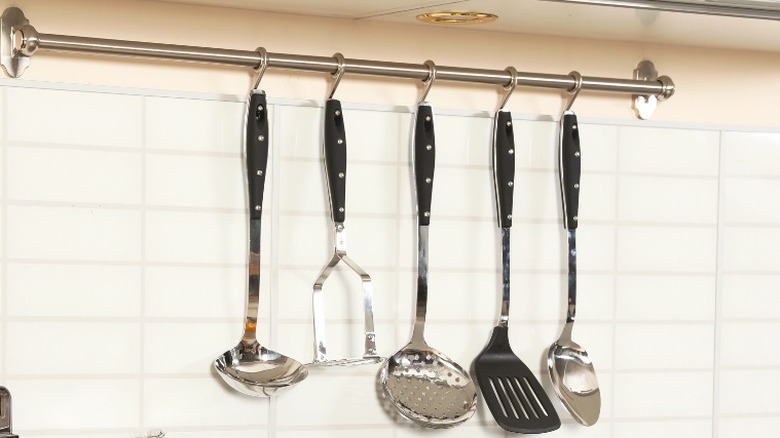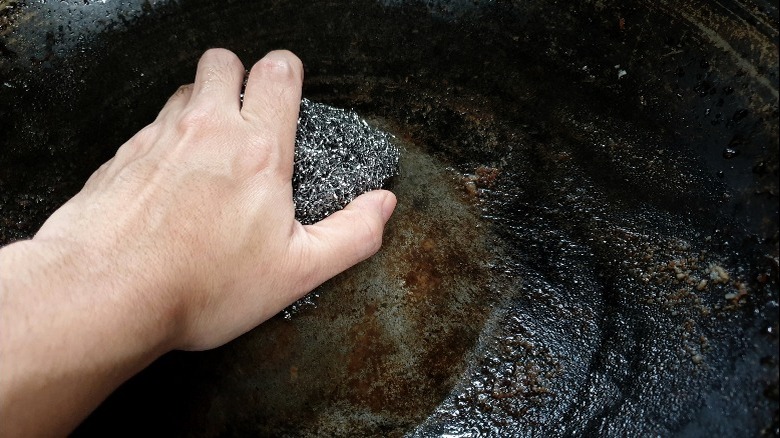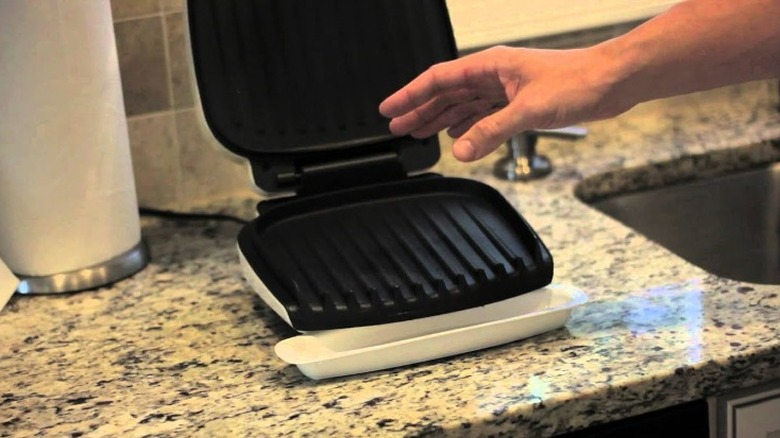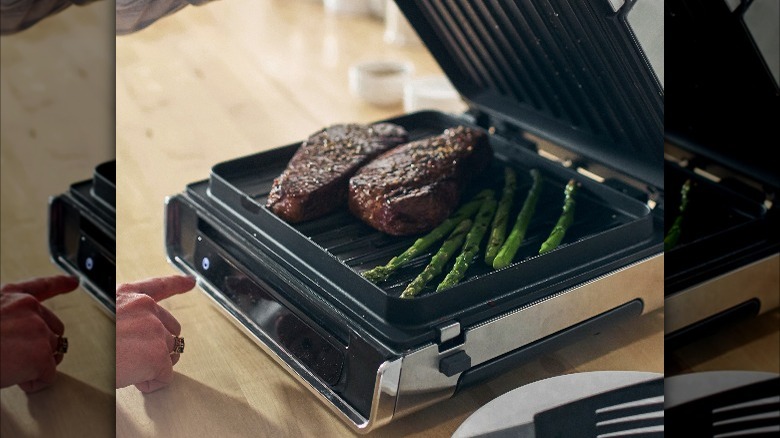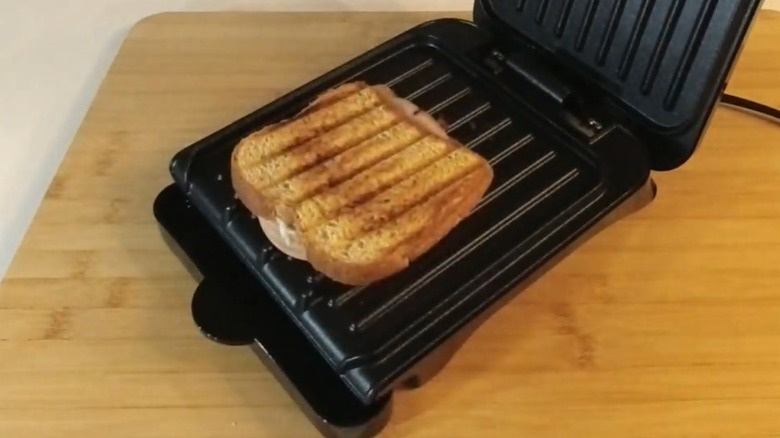Big Mistakes Everyone Makes With George Foreman Grills
Despite its name, the George Foreman Grill was actually invented by Michael Boehm. Back in the 1990s, Boehm wanted to design a tabletop grill that could cook both sides of the food and drain excess fat at the same time. Foreman was the brand ambassador — and personal fan — of the grill and made it a commercial success. Nearly 30 years later, over 100 million George Foreman Grills have been sold.
The grill's popularity stems from its cooking times, fat-reducing design, and nearly foolproof operation. While it was designed to make grilling as easy as possible, it's also surprisingly easy to make mistakes when using it. Whether it's forgetting that it needs time to preheat first, or skipping the proper post-grilling cleanup steps, many George Foreman Grill owners are making mistakes that prevent them from getting the most out of their tabletop grill. Here are the most common mistakes you'll want to avoid if you just picked up a George Foreman Grill of your own.
Not preheating the grill
It only takes about five minutes to preheat the grill. But plenty of people skip this step, and just plop their food on cold plates. This not only makes it take longer to cook your food, but it can also lead to uneven and dry results. You might feel too impatient to wait for the grill to preheat, but you'll be adding those minutes to your cooking time anyway, so you might as well hang tight.
A good way to remember to preheat your grill is to plug it in and turn it on before you start prepping the food you want to grill. Then, you can let it heat up while you're slicing chicken filets, seasoning burger patties, or chopping veggies. By the time your food is ready for grilling, the plates should be hot enough to toss it right on the grill. While different models will vary slightly, most have an indicator light on them to let you know when it's reached the right temperature for cooking.
Using a cooking spray on the grill
Your common sense might tell you a nonstick spray is necessary to keep your food from sticking to the grill plates. But this is a huge mistake when using the George Foreman Grill — or any cookware with a nonstick surface, for that matter. Why? Because the lecithin found in many cooking sprays will stick to that nonstick coating. Lecithin is a chemical that helps the cooking oil come out of an aerosol can. If you keep using the spray, it will build up over time, turning your formerly nonstick grill into a very sticky grill.
The George Foreman Grill user manual itself warns that you should avoid aerosol sprays. Instead, buy a refillable spray bottle — preferably one that delivers a fine mist — and just fill it with your favorite cooking oil. Spritz each grill plate before you plug it in, and you'll get the added nonstick boost you're looking for without the chemical buildup that comes with aerosol sprays.
Using low smoke point oils like olive oil
The smoke point is the temperature at which an oil will begin to burn and produce smoke. This matters because the burnt oil will add an acrid, burnt taste to your food. Plus, if you're cooking indoors, you don't want all that smoke building up in your home. Some cooking oils can withstand higher temperatures than others before they begin to create visible smoke. Most George Foreman Grills are designed to heat up to around 400 degrees Fahrenheit. That means you want to avoid butter, olive oil, and coconut oil, all of which have a smoke point of around 350 degrees Fahrenheit or lower. Instead, reach for corn or grapeseed oil — or even a blended vegetable oil — which have smoke points above 400 degrees. They are also relatively neutral in taste, so they won't impact the flavor of your food too much.
If you want the flavor of a particular oil in your final dish, consider adding it after it cooks — drizzle a little olive oil over your grilled veggies after transferring them to a plate, or top your steak with a slab of butter while it's resting so it can gently melt into the meat. That way, you will get all of the flavor with none of the smoke.
Adding your oil after the grill is already preheated
This is a common nonstick cookware mistake. For cast iron, steel, and similar cookware, adding the fat to an already hot pan makes sense because heat helps the metal expand, closing up the microscopic pores on its surface. Instead of sinking into the pores of a cold pan, the oil remains suspended on the surface where it can create an effective nonstick layer for cooking. But when it comes to the George Foreman Grill, which already has a nonstick coating, these rules don't apply. To protect the nonstick coating, you actually want to add the oil while it's still cold. When heated dry, the nonstick coating will gradually get destroyed, making it a less effective nonstick surface. It can also end up releasing harmful fumes into the air (via Southern Living).
So, be sure to spritz or brush on some oil before you turn the grill on. Even if you're aiming for a low-fat meal, this is still a good idea to maintain a safe cooking surface for the long term. You'll still be able to control the fat content with the slanted drip plate design of the George Foreman Grill, anyway.
Overloading the grill
One of the reasons the George Foreman Grill can deliver perfectly grilled burgers and veggies in minutes is that its double-plate design allows it to cook all sides of the food at the same time. If you overcrowd the plate, though, it won't be able to do that so well. An overcrowded grill will cook the top and bottom, but it might struggle to cook the edges or interior of the food.
So, if you notice that your food still doesn't look quite done even though the recommended cooking time has gone by, you may have overloaded your grill. You don't have to cook one item at a time, though. Just pay attention while you place each piece of food on the grill, and make sure no two pieces are touching each other. Each piece of food on your grill should have a small gap of empty space on all sides.
Cooking foods with different thickness at the same time
Another mistake that can cause your food to cook unevenly or spend more time on the grill is adding items of different thicknesses at the same time. If you toss a thick steak on the grill, the upper grill plate will rest on top of the steak. So, any green beans, onion slices, or other slimmer items you're trying to cook together will only be in contact with the lower plate.
Depending on what you're cooking, you can usually avoid this problem by cutting your ingredients more uniformly. When grilling carrots, for example, chop them into matchsticks or strips that are about the same thickness. Slice potatoes into uniform discs or cut them french fry style. For burgers, make sure every patty contains roughly the same amount of ground meat and is pressed flat until they look about the same. For foods that you can't cut or adjust, like steak, you'll need to plan for batch cooking each piece individually — or at least only cooking it with other pieces of the same thickness.
Not cutting your chicken breasts before grilling
Cooking chicken thoroughly without burning the outside or drying it out can be tricky, even with the George Foreman Grill. That's because, even if it doesn't look especially thick, most chicken breasts tend to have varying thicknesses — being thinner on the ends and thicker in the middle. So, the thinner parts will cook through long before the thicker center, and by the time the center is finished, those thinner edges will be dry and possibly burnt.
To avoid this, slice the breast in half lengthwise before grilling. If the halves still look like they have rounded, thicker parts, use a meat tenderizer to even it out. For chicken breasts that already look mostly uniform all the way across, a few whacks from a meat tenderizer is still a good idea. Taking the time to do this extra prep can result in a juicier, more flavorful grilled chicken. Plus, you'll get those few extra minutes of prep back by shortening the time it needs to cook all the way through on the grill.
Leaving your food on the grill too long
This is a really easy mistake to make, especially if you're used to cooking with a standard grill or a pan on your stove. Those cooking methods only expose one side of your food to heat at a time, so it takes a little longer to finish since you have to cook each side separately. If you're used to a chicken breast taking about five to eight minutes per side in a pan, or leaving burgers on a grill for about 10 minutes, you might default to using those same cooking times for your George Foreman Grill.
But doing that can lead to dry, burnt, or just generally overcooked meals since the George Foreman Grill is cooking both sides at the same time. To avoid that mistake, look for recipes that were specifically written for this grill so that you know the cooking times given are right. Another option is to just adapt your favorite grilling recipes by cutting the cooking time in half. This might require some trial and error until you nail down the perfect cooking time. If a burger normally needs 10 minutes, check on it in five minutes. If it still doesn't look quite done, close the grill, and let it cook another one or two minutes before checking again.
Using metal cooking utensils on the grill
Another important way to protect the nonstick coating on your George Foreman Grill is to avoid metal utensils. They may work great with your standard grill, but they are liable to scratch the coating on the nonstick plates. This is true of any other nonstick cookware you own. Once that coating is scratched, it's just going to keep chipping away — and ending up in your food. Eventually, you'll have an uneven surface where some parts are nonstick, and some parts aren't.
Instead, use wood or silicone cooking utensils. Nylon is also a safe option, but it usually isn't as heat tolerant as wood or silicone, so you'll find it becoming brittle, broken, or even melted if you use it often on your sizzling hot grill plates. While all three materials are much gentler on your nonstick cookware, they don't perform exactly the same. Silicone spatulas can be a little too flexible for lifting a heavy piece of food, for example. For that, you'll probably want a wooden spatula. A silicone spatula will be handy later when you're trying to scrape grease and debris off the grill plates. It molds to the surface well to lift every last drop of grease without damaging the nonstick surface.
Using grill brushes or abrasive cleaners to clean the nonstick grill plates
Just as metal utensils can scratch your grill plates, so can abrasive cleaners or cleaning supplies. As tempting as it is to use a scouring pad or the abrasive side of your sponge on any stuck-on bits of food, you should resist the urge. Even some of the more powerful dish detergents and soaps — particularly the ones meant to cut through grease or caked-on food — can be too abrasive for nonstick cookware. Using these tougher soaps once in a while won't kill the plates, but you should have a gentler dish soap on hand to use as your go-to for cleaning the grill plates.
If you need more scrubbing power than a soft sponge can give you, opt for silicone scrubbing pads or brushes. Better yet, scrape off any bigger bits of food with a wood or silicone spatula while the plates are still fairly hot, and the food hasn't completely dried onto the surface. That way, you just need to wipe away the debris when it's time to clean them.
Not letting the grill plates cool before washing them
Even if you're a diligent clean-as-you-go cook, you need to let your George Foreman Grill cool down before you clean. Putting sizzling hot grill plates in cold water can warp or even crack them. Even the hottest setting on your tap is still going to be a lot colder than 400-degree-Fahrenheit grill plates. So, if you want your grill to last, don't clean them right away.
When your food is finished cooking, turn off the grill, and then go enjoy your meal. By the time you've finished eating, the grill plates should be cooled down enough that you can put them in the dishwasher with your dinner plate if the grill plates are removable. If they aren't removable, they should still be cooled down enough that you can wipe them down, and clean out the drip tray while you're washing your dinner plate. Either way, make sure to dry the grill plates off completely before storing your grill.
Cooking bone-in meat with the grill
While you technically can put a bone-in cut in your George Foreman Grill, most cooks don't recommend it. Bone-in meat takes longer to cook through, and the contact grilling design means the outside of your meat will be directly exposed to high temperatures. By the time the inside is cooked through, the exterior is likely to be charred black. If it's a chicken thigh or other cut with the skin on, you can simply remove the burnt skin after cooking. But if it's a steak or pork chop, you won't have that option. If you bought a bone-in cut, use a knife to carefully remove the bone before cooking.
You can also try a reverse searing technique if you want to keep the bone in place. Instead of putting the meat straight on the grill, stick it in the oven or sous vide it on low heat first to gently cook the meat through. Then, just take it out and place it on your grill for the last couple of minutes to get the crisp exterior you want.
Only using it to grill meat and veggies
When you think of traditional grilling, you might be mostly imagining burgers, hot dogs, steaks, and an assortment of grill-friendly veggies like onions, corn, or bell peppers. These are all great to cook on George Foreman Grill, but they are far from the only things you can cook with it. And limiting your use of it to just the foods that you normally cook on a grill can make you feel like you aren't getting as much use or variety out of your new George Foreman Grill as you hoped.
The double-plate design makes it an especially good panini press, for example. So, next time you whip up your favorite sandwich, toss it in your grill for one to two minutes to turn a quick turkey sandwich lunch into a perfectly toasted treat. Speaking of sandwiches, use your George Foreman Grill next time you're craving a grilled cheese sandwich. It'll be done in minutes with no need to flip halfway through. Fry your eggs. Grill your sausage. Toast your bagel. Make pancakes or waffles. "Bake" cookies. You can even make quesadillas or pizza with your grill. Lots of your favorite meals can be adapted to cooking on the grill, so don't be afraid to experiment and get creative.
